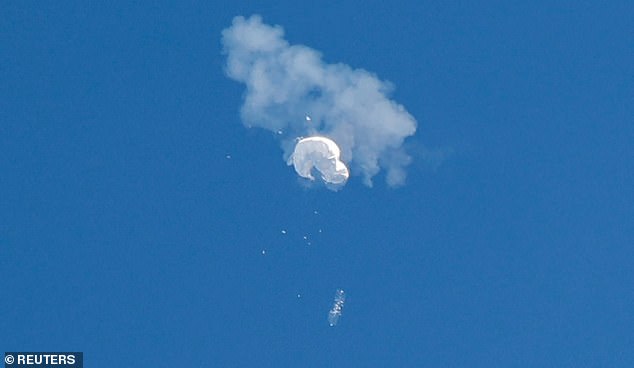What are spy balloons, how do they work and why wouldn't China use a satellite? Everything you need to know about the 18th-century tech that has ratcheted up US-Beijing tensions
- US officials said balloon was part of China's surveillance and intelligence efforts
- It was shot down on Saturday off South Carolina coast by an F-22 fighter jet
- Here's what we know about the device, which offers an alternative to satellites
Chinese-American relations took a nosedive at the weekend when the US destroyed a 'spy' balloon launched from Beijing.
The massive white orb had drifted across US airspace before being shot down by a fighter jet over the Atlantic on live TV on Saturday.
China claimed ownership of the balloon and insisted it was an unmanned weather surveillance aircraft that had veered off-course, but the US remains unconvinced.
US officials have said it was being used for surveillance and intelligence collection, although it did not pose 'a military or physical threat'.
Here's what you need to know about spy balloons – from how they work to why they're being used as an alternative to satellites.

How does a spy balloon work? China's surveillance balloon is still shrouded in mystery to some extent, but experts say it could have sensors, a radar, and multiple cameras pointing down at Earth's surface. These could have powerful zoom and infrared capabilities to see in the dark

The huge, high-altitude Chinese balloon sailed across the US on Friday, drawing Pentagon accusations of spying and sending excited or alarmed Americans outside with binoculars
WHAT ARE SPY BALLOONS?
Spy balloons are huge, high-altitude balloons, each around the size of three buses, that are used as surveillance devices.
They provide an alternative surveillance option to satellites, which are at a higher altitude in low or medium-Earth orbit.
These spy balloons have high-tech equipment attached, including cameras and sensors.
China's spy balloon was spotted ahead of a planned trip to Beijing by US secretary of state Antony Blinken, which has now been postponed.
The balloon entered US airspace over Alaska on January 28, before drifting over Canada and then back into the US.
A US fighter jet shot the balloon down over the Atlantic off the coast of South Carolina on Saturday, a response China described as an 'obvious overreaction'.
HOW DO THEY WORK?
Spy balloons contain gas such as hydrogen and helium that help them float with the wind, but US officials said this balloon had propellers to help steer it.
The Pentagon said the balloon was maneuverable and showed it could change course.
Spy balloons typically operate higher than commercial airplanes or even fighter jets and spy planes.
According to reports, China's balloon this week was registered floating at around 60,000 feet (11.3 miles), while most commercial airliners go up to 40,000 feet.

Surveillance balloons typically operate higher than commercial airplanes or even fighter jets and spy planes

The balloon was shot down Saturday off the coast of South Carolina by an F-22 fighter jet (pictured here in file photo)
According to the Washington Post, the lower part of the balloon has a 'ballonet', which can let in and out surrounding air.
If there's enough surrounding air in the ballonet, the whole balloon will sink, because this air is heavier than the helium above it.
The balloon can then rise and sink to catch winds that blow in the required direction, although this process can be aided by additional propellers.
WHAT SPY DEVICES WOULD THE BALLOON HAVE?
The surveillance balloons are equipped with cameras, sensors and radars, which point down at the ground, all powered by attached solar panels.
Sophisticated cameras allow them to take photographs of what's down on the Earth's surface, potentially with powerful zoom capabilities.
It's even likely these cameras can see outside of the visible part of the electromagnetic spectrum, such as infrared, letting them observe at night.
'If it's nighttime, a camera operating in the visible part of the spectrum is not going to show you anything – it's all going to be dark,’ said aerospace engineer Iain Boyd at the University of Colorado Boulder.
'But an infrared camera can pick up things from heat in the dark.'
The US was concerned because the balloon loitered over sensitive areas of Montana where nuclear warheads are siloed.
China insisted it was a weather surveillance aircraft, but according to the US it was carrying equipment in the pod under the balloon that is not usually associated with standard meteorological activities or civilian research.
IS THE SPACE BALLOON DANGEROUS?
The Pentagon said on Thursday evening that the balloon was not a military or physical threat – in other words, it was not carrying weapons.
However, it's thought the primary danger to the US was potentially compromising the secrecy of sensitive sites.

The balloon's solar panels can be made out from this shot. China has claimed ownership of the device but has insisted it was a weather surveillance aircraft

The suspected Chinese spy balloon drifts to the ocean after being shot down off the coast in Surfside Beach, South Carolina, February 4, 2023
Even if the balloon was not armed, it posed a risk to the US, said retired Army General John Ferrari, a visiting fellow at the American Enterprise Institute.
The flight itself, he said, could be used to test America's ability to detect incoming threats and to find holes in the country's air defense warning system.
It may also have allowed the Chinese to sense electromagnetic emissions that higher-altitude satellites cannot detect, such as low-power radio frequencies which could help them understand how different US weapons systems communicate.
China's weather balloon excuse should be dismissed outright, said Oriana Skylar Mastro, an expert on Chinese military affairs and foreign policy at Stanford University.
'This is like a standard thing that countries often say about surveillance assets,' Mastro said.
WHEN WERE THEY FIRST USED?
Balloons used for surveillance aren't new and primitive ones date back centuries, as far back to the late 18th century.
In 1794, the French used manned air balloons to observe the enemy during the Battle of Fleurus, but they came into greater use in World War II.

Monitoring an adversary from a balloon dates back to 1794, when the French used a hot air balloon to track Austrian and Dutch troops in the Battle of Fleurus
During the conflict, Japan launched thousands of hydrogen balloons carrying bombs, and hundreds ended up in the US and Canada.
Most were ineffective, but one was lethal; in May 1945, six civilians died when they found one of the balloons on the ground in Oregon, and it exploded.
According to Boyd, the US flew many balloons over the Soviet Union in the 1940s and 1950s too.
'Those were eventually replaced by the high-altitude spy airplanes, the U-2s, and they were subsequently replaced by satellites,' he said.
WHY IS CHINA USING BALLOONS WHEN IT HAS SATELLITES?
Balloons are likely cheaper and easier to launch than satellites, which tend to require a launch from a rocket.
China may also be wanting to demonstrate to the US that it has a host of technology options when it comes to surveillance, but there may be other explanations for the bizarre episode.
China's vice foreign minister Xie Feng has said he's lodged a formal complaint with the US Embassy over the 'US attack on a Chinese civilian unmanned airship by military force'.
Reacting with anger at the US's decision to shoot down the balloon may also play into China's hands, by giving it a degree of moral or political leverage.
John Blaxland, professor of international security and intelligence studies at the Australian National University, thinks China wanted the balloon to be detected when it entered US airspace.
'It's hard to think how they could have thought that it wouldn't have been detected,' Professor Blaxland told The Guardian.
'American airspace is so closely studied, by the US civil aviation authorities, by the US air force, the US space force, the weather networks — it's extremely scrutinised airspace.'
Meanwhile, Boyd said China is likely 'experimenting to see how far they can push things' and that the balloon is probably 'some kind of political message'.
WHAT HAPPENS NEXT?
The hunt is now on by US authorities to find the remaining fragments of the balloon, which could reveal more about its capabilities.
Chuck Schumer, the US Senate Democratic leader, said the downing of the balloon 'wasn't just the safest option, but it was the one that maximized our intel gain'.

This photo shows US Air Force fighter aircraft shooting down the suspected Chinese spy balloon off the Carolina coast on Saturday
That was because any instrumentation on the airship was more likely to survive a water landing than if it had been shot down earlier over land.
There is currently no timeline on the recovery of the balloon from the Atlantic Ocean, but officials estimated that it would be done in a short time.
When recovered, the balloon debris will be analysed in Quantico, Virginia, home of the FBI headquarters.
Christopher Twomey, a security scholar at the US Naval Postgraduate School in California, said any Chinese response would be limited.
'I'd expect they'd protest moderately but hope to sweep this under the rug and reinstate progress on senior-level visits within months,' Twomey told Reuters.
Most watched News videos
- Cop walks past woman set on fire on subway as suspect watches
- Brit seen taking prostitute to his room days before she was found dead
- Helicopter crashes into hospital killing four during foggy takeoff
- Driver speeds past horse riders on country lane in road rage
- Woman goes on entitled drunken rant after arrest for catfight
- North Korean troops wiped out by Ukrainian kamikaze drones
- Heartstopping moment passenger almost dragged under moving train
- Moment driver collapses to floor as she is so drunk
- Councilor captures shocking video of bridge collapse in Brazil
- Authorities shut down NYC subway station after woman found on fire
- Terrifying moment cargo ship capsizes on port endangering crew
- Drones plummet to earth during light show, seriously injuring child






















































































































































































































